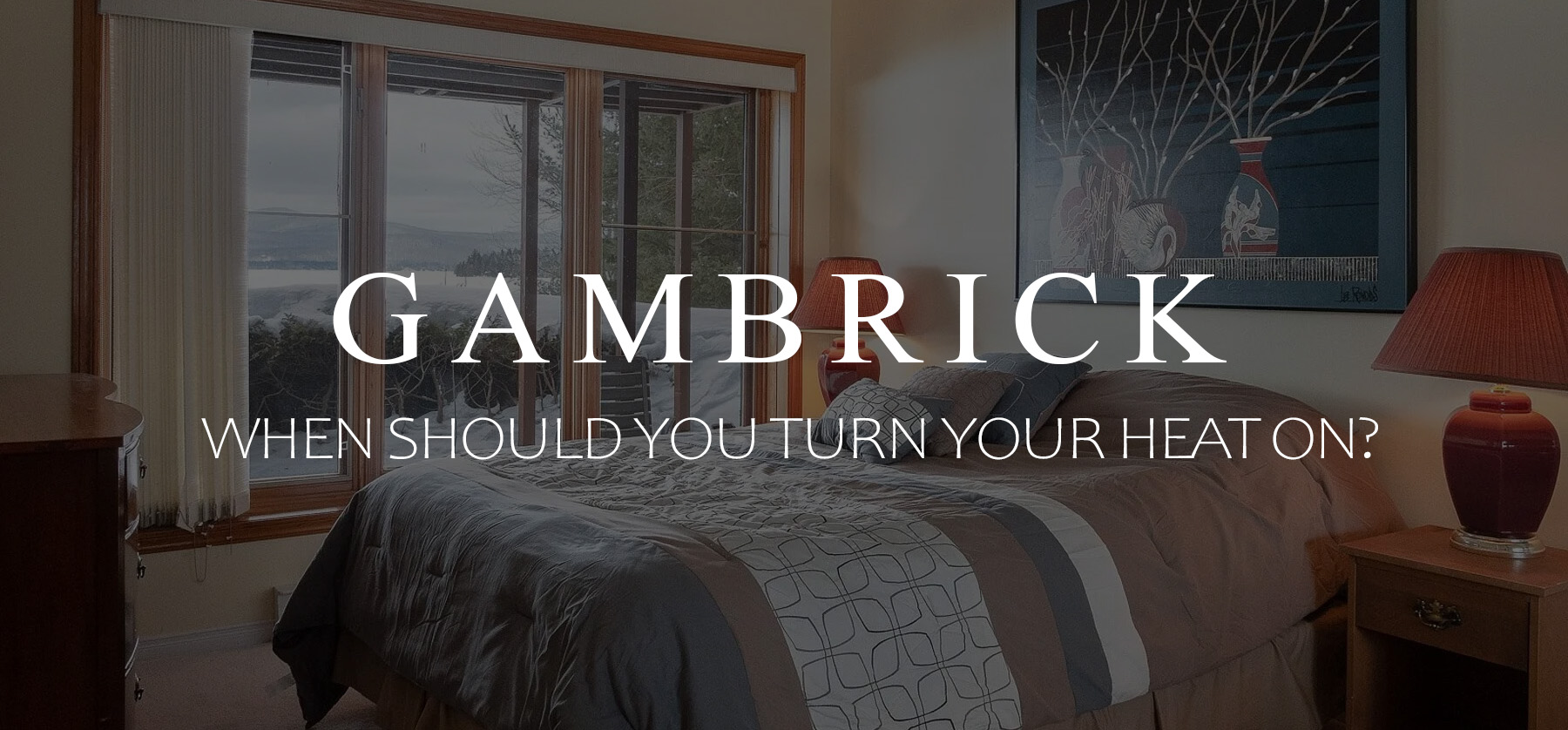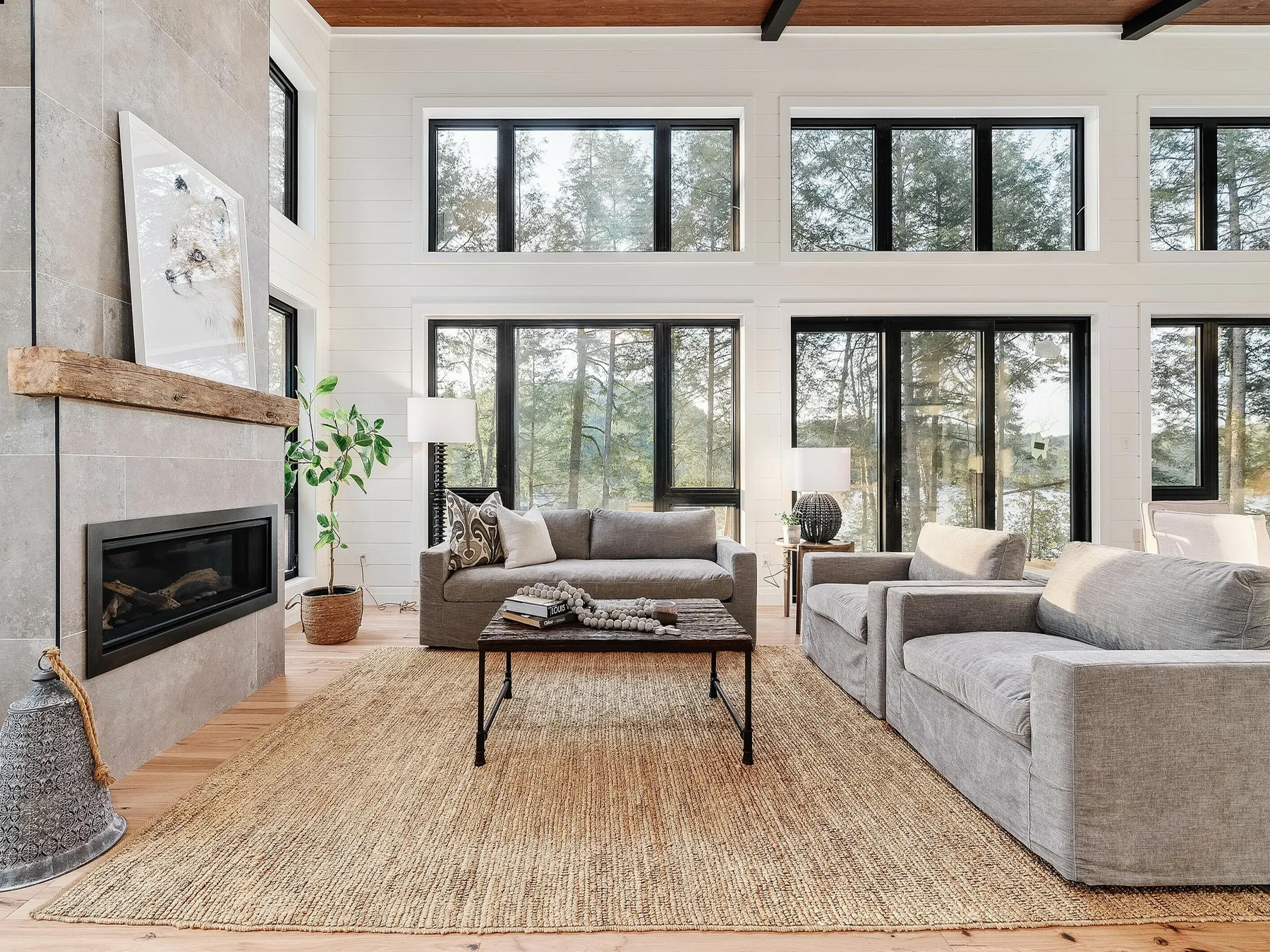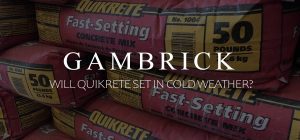When Should You Turn Your Heat On?
Knowing when it’s the right time to turn on the heat is important when temperatures start to drop. Most experts recommend turning on the heat when indoor temperatures fall below 64° Fahrenheit. But I like to set my thermostat a bit higher at 68°F. Your personal preference and the house you live in play an important role in determining your heat settings. If your house is new and has proper insulation you can set the thermostat a little lower. A well insulated home will have less cold spots, temperature fluctuations and drafts. However an older home with less insulation typically needs a thermostat set higher.
Homes with less insulation and older windows usually have drafts and cold spots. Temperatures fluctuate more so its harder to keep the house comfortable. To compensate you should set the thermostat a little higher than normal. In some really old homes I set it as high as 70°F.
Where your thermostat is located plays a role too. The heat turns on and off based on the temperature you set your thermostat. But the thermostat only measures the temperature around it. It may be 70°F at the thermostat but 60°F in rooms far away. This is a common problem in older homes that have drafts and cold spots. Too keep the house more comfortable position your thermostat in a place that has the most accurate reading. Don’t place it by a kitchen or laundry because those rooms tend to get hotter. I recommend installing it in the room you spend the most time in.
In this article we’ll discuss when you should turn the heat on and how warm it should be set once you finally do?
Should You Turn on the Heat?
Knowing when’s the right time to turn on the heat depends a lot on the person and the home.
Most experts recommend turning on the heat when the indoor temperature is below 64° Fahrenheit. However that’s a bit cold for a lot of our customers. If you have children or seniors living in the house that temperature is usually set higher. I usually recommend setting the thermostat to 68° Fahrenheit in the average home.
The house you live in means a lot. The temperature reading on the thermostat doesn’t always reflect the overall temperature of the house. Pay attention to where the thermostat is located. It could be in a hot or cold area of the home.
Make sure your thermostat is working properly. Older units aren’t as reliable as the new digital thermostats. You could be getting an incorrect reading which would effect where you set the heat.
Here are a few general guidelines I use when turning on the heat in a home:
- If a house is older, has insufficient insulation or drafts, set the thermostat a few degrees higher.
- Place the thermostat in a central part of the home away from hot or cold spots.
- Don’t place the thermostat near a kitchen or laundry.
- Install the thermostat where you spend the most time.
Regardless of how old or new your house is, set the heat to a place you feel comfortable. There’s no definitive best temperature for comfort. But overall the best temperature for most people is in the 64°F to 68°F range.
How Cold Does It Have To Be Outside To Turn The Heat On?
Outdoor temperature shouldn’t determine when you turn your heat on, indoor temperature should.
There’s a variety of reasons why one house may feel cold while another feels warm even when the outside temperature is the same.
Here are a few important things to consider:
- A well-insulated house with good thermal mass will stay warmer than one that isn’t.
- Energy-efficient windows and doors help maintain indoor air temperature.
- The position of the home plays a role too. Houses that gets lots of sunshine are generally warmer than home’s in the shade.
- Drafts are a huge issue. A homes that’s sealed tight will feel warmer than one that’s drafty.
- Build material matters too. Brick, stone and concrete home’s absorb and release heat slowly over time. They generally feel warmer than homes built out of wood or sided with vinyl.
- House design is another issue. Single story homes can feel warmer if the ceiling is properly insulated because heat stays within the living space. Two story homes or homes with cathedral ceilings feel cooler because heat rises to the second floor or towards the high ceilings.
- Humidity is a factor too. In most cases, a humid climate feels warmer than it actually is. But thermostats only read air temperature not humidity. Adjust your setting according to how the house feels.
When determining the right temperature to turn your heat on, consider the inside temperature and not the outside. Every house is different so adjust based on how the inside of your home feels.
What Temperature Should The Heat Be Set At?
The World Health Organization (WHO) has outlined standards for healthy indoor temperatures. WHO recommends a minimum indoor temperature of 64.4°F. But that’s a little cool for some homes. Most of my customers prefer a thermostat set between 68°F and 70°F.
Keep in mind these temperature settings are recommendations and need to be adjusted based on the homeowner and house.
- If a home is older with poor insulation or drafts you’ll most likely need to set the thermostat higher to compensate.
- Duct quality is a problem too. If you lose heat due to duct leaks you’ll have to turn the settings up a bit until you seal the ducts.
- Drafts are another problem. Until you seal the drafts you’ll have to set the thermostat higher.
- If your home is brand new and well insulated you can generally set the thermostat lower.
- Home’s that get lots of sun can generally use a lower setting during the day.
- Masonry homes usually require a lower setting because they absorb and slowly release heat.
- Super high energy efficient homes like Passive House don’t use much heat at all.
Adjust the heat setting in your home based on how it feels, not simply the number on the thermostat.
If your home has cold or warm spots, make sure you adjust the thermostat based on where you spend most of your time. And keep the thermostat in a common area away from other heat like a kitchen stove, laundry or direct sunlight. They can throw off the reading.
Personal Preference
Your own personal preference is a big factor when turning the heat on and setting the thermostat. Some people simply like a cooler house than others.
Setting the thermostat lower and turning the heat on later in the season definitely saves money on heating costs. There’s no set right temperature to set the heat or time when you should turn it on. All of these temperatures are just recommendations.
Sleeping Temperature
It’s been proven in numerous scientific studies you sleep better when it’s a bit cooler rather than warmer. Many homeowners set there thermostats to lower during the night as they sleep.It’s also programmed to turn up an hour or so before they wake in the morning.
Using a programmable thermostat can save you money at night while creating an environment better for sleep.
What’s The Best Temperature To Set The Thermostat In Winter?
Winter is when outside temperature are the coldest. This means you need more active heating inside the home to regulate temperature. You may be able to get away with not using the heat much in Fall, but you’ll need it during a cold Winter. So what’s the best temperature to set the thermostat to in Winter.
Energy Star say it’s at that temperature where your home is the ideal balance of comfort and energy efficiency. This is a fancy way of saying personal preference. Overall the most common thermostat setting in Winter are still between 68°F and 70°F.
The big difference in Winter is drafts. Because Winter air is so cold, even small drafts can make the heat run all day. No matter what you set the thermostat too drafts will suck the heat right out of your house. Make sure to seal those drafts as well as possible before Winter and consider using heavy drapes in front of windows. Also adjust your furniture so that you don’t block radiators and air vents. And properly service your furnace.
Lower Heat = More Savings
It’s tempting to raise the heat during the winter. But those high settings come with a big price tag. And they may not help your home feel that much warmer.
Before you simply turn up the heat this Winter, do three very important things.
- Inspect Your System: Make sure your heating system running correctly. Even something as basic as a dirty filter can be reducing your heating systems efficiency.
- Look For Drafts: This not only includes windows and exterior doors but also your leaky duct work. Seal all the exterior drafts you find with caulk or insulated strips. Also try installing heavy drapes in front of drafty windows. Seal leaky ducts with tape, insulation and/or new ducts.
- Furniture: make sure bulky furniture isn’t blocking your ducts or radiators.
I recommend setting your thermostat around 64°F when the house is empty, or at night when your sleeping.
Raise the temperature when you’re at home using the house.
Turning your thermostat back by 7°F to 10°F for 8 hours a day from its normal setting will save you up to 10% a year on heating costs. Keeping the home at a lower interior temperature actually slows down heat loss because the inside and outside temperature are closer.
Save money by lowering the temperature about 7°F to 10°F at night while you sleep. Studies show that cooler air can help you sleep and save money.
A programmable thermostat really comes in handy here. They even come with WiFi so can check the temperature and adjust your heat from just about anywhere.
Things To Do Before Turning On Your Heat
There are a number of things you should do before turning the heat on every year. Most of these things you can do yourself. But if want to hire a Pro call a local HVAC company.
Change Or Clean The Filter
Dirty filters can make your heating system run inefficiently. This means they won;t produce as much heat as they should. Start your system with a clean filter and clean or replacing it when required for best usage. A clean filter means better indoor air quality and a more efficient heating system.
Yearly Maintenance
Doing some routine yearly maintenance at the start of every season can help prevent a system failure at the worst times. An annual check up helps ensure efficient heating which can save money in the long run.
System Test
I always recommend doing a full system test before temperatures get too cold. Run the system on high for a while and look for problems, weird smells, sounds or heat loss. It’s best to find an issue at the start of a season before it gets too cold.
This is extra important if you do your yearly maintenance at the end of the Winter season instead of at the beginning during Fall.
Seal Drafts
A little weatherstripping and/or caulk can save you a lot of money over a season. Heat loss caused by drafts is a big problem in older homes. Reducing the amount of cold air getting into your house lowers the amount you have to use the furnace.
Adjust Furniture
Another common issue I find with heating systems working improperly is furniture.
Adjust your furniture so it isn’t blocking heating vents or radiant heaters. Make sure vents and radiators are open and clear so that heat can freely flow into the room.
Rugs and drapes can improve heat retention by blocking drafts. If you have southern-facing windows open the drapes in the daytime to let in sunlight. Then close them at night to prevent drafts.
Why Isn’t My Heat Turning On?
If the temperature outside starts to drop and the heat doesn’t kick on, it may not be cause for concern. There are a few common reasons why.
Here are a few things you can check yourself:
- Humidity makes the air feel warmer than it actually is. If humidity drops, like is usually does in the fall, 70°F can feel cooler than it did a few weeks or even days ago. If the air temperature is relatively the same the heat won’t come on even though it may feel cooler. This is because thermostats only read air temperature and not humidity. If this happens you should adjust the thermostat accordingly to make the heat kick on.
- Check your thermostat settings. What temperature is it set at? In many cases the thermostat just needs an adjustment. This is very common with newer digital thermostats that are harder to program than much simpler older models.
- Check the temperature directly around the thermostat. In many cases the room where the thermostat is located is warmer than the rest of the house.
- Check the wiring. I’ve been called to a number of houses simply to find the thermostat wires weren’t connected properly. If the wires are loose or disconnected the signal can’t go from the thermostat to the furnace telling it to turn on.
- Turn the thermostat to a much lower temperature to see if the furnace engages. If it doesn’t then there’s a more serious issue and you should call an HVAC company.
Consequences Of Not Turning On Your Heat
It’s important to turn your heat on at the appropriate time of year.
If you wait too long to turn on your heat, materials used to build your home can start to absorb moisture. Most modern materials need to exist in a temperature controlled environment. The biggest example of this is drywall. If the temperature isn’t controlled while air gets cool and damp, mold can start to grow.
Heat evaporates moisture that builds up in the air. Try to keep temperatures above 64°F inside the home to keep humidity under control.
Another big issue is freezing pipes. Even if your house is a summer home, you should still use a programmable thermostat that can keep temperatures above freezing and at a comfortable level during Winter months.
Summary: When Should You Turn Your Heat On?
Knowing when it’s the right time to turn on the heat is important when temperatures start to drop. Most experts recommend turning on the heat when indoor temperatures fall below 64° Fahrenheit. But I like to set my thermostat a bit higher at 68°F. Your personal preference and the house you live in play an important role in determining your heat settings. If your house is new and has proper insulation you can set the thermostat a little lower. A well insulated home will have less cold spots, temperature fluctuations and drafts. However an older home with less insulation typically needs a thermostat set higher.
Homes with less insulation and older windows usually have drafts and cold spots. Temperatures fluctuate more so its harder to keep the house comfortable. To compensate you should set the thermostat a little higher than normal. In some really old homes I set it as high as 70°F.
Where your thermostat is located plays a role too. The heat turns on and off based on the temperature you set your thermostat. But the thermostat only measures the temperature around it. It may be 70°F at the thermostat but 60°F in rooms far away. This is a common problem in older homes that have drafts and cold spots. Too keep the house more comfortable position your thermostat in a place that has the most accurate reading. Don’t place it by a kitchen or laundry because those rooms tend to get hotter. I recommend installing it in the room you spend the most time in.
If you have any questions about when to turn your heat on, email any time.






















